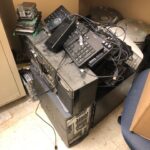
Just as many of the early tech innovators were Black Americans, there were also many women. Women were in computing from the very beginning, doing complex math computations by hand and eventually becoming the first programmers. “Softwork,” which evolved into “software,” was considered “beneath men.” Here’s just a glimpse of some of the many contributions female tech innovators have made throughout history.
Ada Lovelace is considered the “Founder of Scientific Computing.”
As the daughter of Lord Byron, she traveled in the educated circles of London. In 1833 met Charles Babbage, the inventor of the “Analytical Engine.” Although it was never built, it shared many elements of the modern computer. Ada Lovelace’s notes on the project were the inspiration for the computers built in the 1940’s, a century later.
Hedy Lamar may be best known as a Hollywood actor and World War II spy
but she was also a self-taught inventor. She received a patent in 1942 for her “secret communication system.” It was used to send radio-guided torpedos off course during the war. Her technology inspired today’s WiFi, GPS and Bluetooth.
The ENIAC (Electronic Numerical Integrator & Computer) Programmers
are six women who worked on a secret World War II project. They wrote the code for the first all-electronic programmable computer. When introduced in 1946, they were photographed with the machine but were never acknowledged or credited for their hard work. While Kathy Kleiman was researching her book about the programmers, a representative at the Computer History Museum told her that they were “refrigerator ladies.” They were models, only in the photo to make the product look good!
Elizabeth Feinler Oversaw all internet addresses
as the Director of the Network Information System Center at Stanford. She developed the first search engine with “white pages” and “yellow pages,” like the telephone directories. It was her idea to name domains based on where they were housed, such as military, education, organization or business. The domain suffixes “dot mil,” “dot edu,” “dot org” and “dot com” are still the most common in the domain naming system.
Susan Kare was employee #10 at Steve Job’s first company NEXT.
She worked with him to design the original icons for the MacIntosh computer. The paintbrush, moving watch and trash can elements are her designs still in use today.
Katherine Johnson HAD THE ASTRONAUTS LIVES IN HER HANDS
working on the “Black Team” at the National Advisory Committee of Aeronautics (NACA) in Langley, VA. She manually ran the computations on her desktop that the machine used to send man into orbit. She and her fellow Black American “computers” were showcased in the 2016 movie “Hidden Figures.”
Grace Brewster Murray Hopper CREATED THE BASIS FOR COBOL, STILL USED TODAY
A computer scientist, mathematician and USN Rear Admiral (lower class), she was the first to devise the theory of machine independent programming languages. She believed computer language should be based on English. “It’s much easier for people to write an English statement than it is to use symbols.” Contrary to the prevalent belief at the time, she maintained that data processors could write in English and the computers could then translate it into machine code.
In 2020, Google named the industrial network cable that connected the US, the UK and Spain the “Grace Hopper.” The same year, the United States Naval Academy (USNA) completed the first addition to the Annapolis campus in almost 50 years. Hopper Hall is built specifically for the study of cyber security. It’s also the first USNA building named after a woman AND the first building at ANY of the three military academies. Still.
These women pioneers in the technology field are just a few of the many who helped create today’s technology. We use their innovations daily and may even take them for granted. To help ensure women are recognized for their past contributions and to support and foster their continued contributions, Women In Technology (WIT) was founded in 1992. “WIT empowers girls and women to excel in science, technology, engineering, the arts, and math (STEAM) from the classroom to the boardroom.” Never again will women in technology be dismissed as “refrigerator ladies.”


